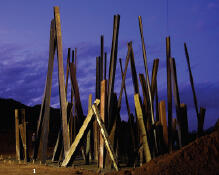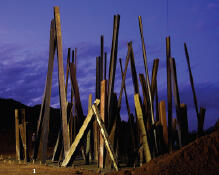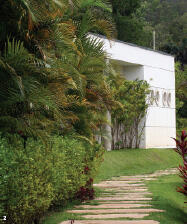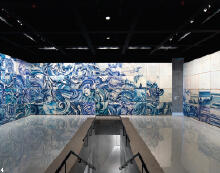COLLECTION: Instituto Cultural INHOTIM
A new way of experiencing Art
A few months ago, up a hill in the middle of Minas Gerais, Brazil, a huge crane was used to lift enormous construction steel I-beams to a height of 60 meters, and then drop them in a pool of about 10 by 10 meters, filled with wet concrete, thus creating a stunning iron jungle, suspended between a catastrophic scenario and an elegy to both the natural surroundings and the historical heritage of the region, that traditionally drew its wealth from mining activities, first of gold and more recently of steel.

Arguably not as traumatic as his mythical performance pieces Shoot (1971) or Trans-fixed (1974), Chris Burden’s Beam drop: Brazil (2008)1 is definitely one of the most impressive works on display at Instituto Inhotim, the not-for-profit, constantly growing (Beam drop itself is not yet open to the public) home of one of the most original contemporary art collections in Brazil. Its originality stems, among other things, from the fact that it includes several large-scale installations, many of them to be considered seminal in their authors’ career, and authentic masterpieces, such as Cildo Meireles’ Desvio para o vermelho (1967) and Através (1989), Doris Salcedo’s Neither (2004), and Tunga’s Lézart (1989).
When, in the early Nineties, entrepreneur Bernardo Paz became friends with Tunga, his collection consisted mainly of Modernist works, but conversations with the artist from Rio de Janeiro, and exposure to works such as Lézart, or, a few years later, True Rouge (1997, another of the highlights of the collection), caused an epiphany that led him to focus exclusively on contemporary art. Based in Belo Horizonte, the State capital of Minas Gerais, Paz displayed part of his collection in his fazenda in Brumadinho, approximately 60 km from the city. There he invited friends, among them artists and architects such as Roberto Burle Marx (1909-1994), the most influential landscape architect in Brazilian history, who personally designed and cultivated part of the gardens that today constitute the spectacular environment for the now-public collection of more than 400 works, part of which is displayed in several pavilions scattered in a garden area of 45 hectares. Another 600 hectares of permanently preserved forest surround the area open to the public, and constitute the Inhotim Environmental Park, dedicated to the preservation of remnants of the Atlantic Forest and the Cerrado (Brazilian savanna) biomes, and to the restoration and maintenance of botanical collections from Brazil and other countries around the world.
Some of the pavilions are entirely dedicated to permanently exhibit one artist, either by showing a single installation, or with a selection of works. Adriana Varejão, for example, occupies a recently inaugurated gallery (a quite impressive concrete box suspended over an artificial pond), designed by São Paulo-based architect Rodrigo Cerviño Lopez, with works from the last decade, including the huge painting installation Celacanto provoca maremoto, originally produced in 2004 and to which a new part was added in order to fill the main room of the gallery. Among the best individual pavilions is the one located in an old carpenter workshop, that hosts Victor Grippo’s delicate installation La intimidad de la luz en St. Ives (1997). Originally conceived for one of the Porthmeor studios in Saint Ives, Cornwall, a space used by many artists throughout the 20th century, the work is a reflection on both the passing of time and the metaphysical battle of the artist with the rough material he uses to create an artwork.
In total, roughly 25% of the collection is displayed at the same time, thus allowing the curatorial team of the Instituto Inhotim, formed by Jochen Volz, Allan Schwartzman and Rodrigo Moura, to select at ease in order to arrange the temporary group exhibitions that occupy four of the pavilions – called Lago, Fonte, Praça and Mata (that is, respectively: Lake, Spring, Square and Forest) –, and are renewed every two years. This wealth of time and the quality of most of the works exhibited conjure to make the collective pavilions just as interesting as those dedicated to one-man exhibitions. The best example is currently the Galeria Mata, where the curators installed a carefully planned exhibition, entitled Pontos de vista (Points of View). Olafur Eliasson’s Viewing machine (2001), a large kaleidoscope which allows one to see outside and inside the gallery, greets the visitors, immediately creating a dialogue with both the surrounding nature, that invades the pavilion through the glass walls (and is perceived in a fully new way when seen through the viewing machine), and the artworks in the following rooms, which include a nostalgic 16 mm film by Jonathan Monk, tautologically entitled A cube by Sol Lewitt photographed by Carol Huebner using nine different light sources and all their combinations front to back and back to front forever (2001), or Jorge Macchi’s Fuegos de artifício (2002), a simple, thus immensely poetical installation by the Argentinean artist, one of the most consistently represented in the collection.
Finally, some works are displayed outdoor, in direct contact with the environment. That is the case of Dan Graham’s Bisected Triangle, Interior Curve (2002) or Simon Starling’s The Mahogany Pavilion (Mobile Architecture nr. 1) (2004). The most impressive example, though, is most definitely Hélio Oiticica´s Magic Square no 5 – De luxe (1978). Conceived as part of the Magic Square series, the penetrável (penetrable, i.e. the name that Oiticica employed to describe his large scale, relational installation where visitors are supposed to enter) is absolutely stunning, its bright colors suddenly revealing the proximity of Oiticica’s researches on colors with archetypical Latin architectures, such as the one of Luis Barragán in México. Oiticica is one of the artists whose work, namely the complete series of his Cosmococas environmental installation, will be permanently hosted in an individual pavilion in the near future, part of an ongoing effort of the Instituto Inhotim to constitute a relevant group of works from the last fifty years that can be considered fundamental for a deep understanding of the most recent developments of contemporary art, something especially encouraging in a country where so few public institutions show such a clarity of programs and goals.







